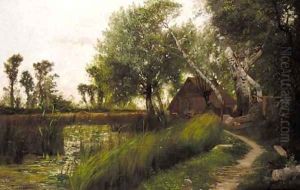Jean Roch Isnard Paintings
Jean Roch Isnard was a French artist and sculptor whose work has been somewhat obscured by the passage of time, yet his contributions to the art world during the 18th century remain noteworthy. Born in 1699, Isnard's period was one of significant artistic evolution in France, which saw the tail end of the Baroque era giving way to Rococo and later, the stirrings of Neoclassicism. His life and career unfolded against the backdrop of the Age of Enlightenment, a time when ideas on philosophy, science, and art were rapidly changing, influencing artistic expressions across Europe.
Isnard's training and early work are not well-documented, but it is clear that he was part of the vibrant French artistic scene. His style would have been influenced by the major artistic movements of his time, as well as by the works of contemporaries and predecessors. The Rococo style, known for its ornate and decorative qualities, emphasizing lightness, elegance, and the use of curved lines, may have found its way into Isnard's work, as it did with many artists of his period. However, precise details of his contributions, specific works, and their impact on his contemporaries and the art world at large are less known.
Despite the lack of detailed records about his life and oeuvre, Isnard's career as a sculptor suggests he was skilled in working with materials such as marble, bronze, and wood, crafting figures and ornaments that reflected the artistic tastes and cultural ideals of his time. His works would have been part of the broader tapestry of French art, contributing to the decorative and aesthetic projects of the 18th century, including possibly commissions for the French aristocracy and the church.
Jean Roch Isnard died in 1781, leaving behind a legacy that, while not as celebrated or extensively documented as some of his peers, played a role in the rich artistic heritage of France. His life and work exemplify the journey of artists during a period of profound artistic transition and innovation. Research into artists like Isnard is crucial for understanding the depth and diversity of art history, highlighting the contributions of those who may not have been at the forefront of their field but whose work collectively shaped the artistic landscape of their time.
